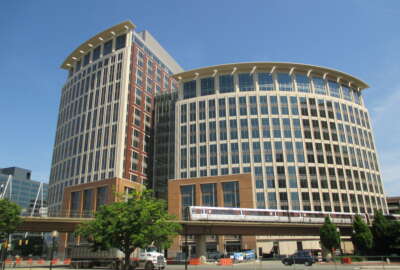This National Science Foundation grant will help forecasters see inside clouds
The National Science Foundation (NSF) has awarded a 90-plus million grant with the purpose of improving understanding of weather.
The National Science Foundation (NSF) has awarded a 90-plus million grant with the purpose of improving understanding of weather. It went to the University Corporation for Atmosphere Research. The result will be an airborne phased radar giving 3-D pictures of weather phenomena. For the details, Federal Drive with Tom Temin spoke with NSF’s Chief Officer for Research Facilities, Linnea Avallone.
Interview Transcript:
Tom Temin And first of all, the program under which this grant was made is something called the.
Linnea Avallone Mid-Scale Research Infrastructure Track 2.
Tom Temin Thank you. You beat me to it. Tell us about that program, first of all.
Linnea Avallone Certainly. So our mid-scale research infrastructure program was first put in place in 2018, and it was specifically designed to fill a funding gap between two longstanding programs, one for major facilities, things that cost more than about $100 million, and our major research instrumentation program, which funds mostly single instruments up to a cost of about four or $5 million.
Tom Temin Got it. And the group to which this grant went, the University Corporation for Atmospheric Research, UCAR. What is that?
Linnea Avallone UCAR is a consortium of about 120 universities and institutions that do work or educate in atmospheric sciences, and UCAR is the managing organization for the National Center of Atmospheric Research, based in Boulder, Colorado. They’ve been in existence almost as long as the Science Foundation has, so since the early 1960s.
Tom Temin And what do you hope to get from this grant? I mean, phased arrays of radar is nothing new. That’s a technology, the military and I think some of the civilian agencies [NASA and National Oceanic and Atmospheric Administration (NOAA)] already use. So what are you expecting to come from this?
Linnea Avallone Right. That’s a great question. So phased array radar, as you said, has been around for military use for quite some time, but we’ve actually never used it really for scientific purposes to study clouds, to study severe storms. So what this technology will do is replace existing and some retired radars that have been used for atmospheric research for many decades with much higher resolution, spatial and temporal resolution observations.
Tom Temin So UCAR will be retrofitting existing equipment with the means to become more accurate.
Linnea Avallone Not exactly. They’re actually developing a whole new radar, so it’s a different wavelength of radar than you’re normally used to seeing. So, for example, National Weather Service radars used what’s called S-band, and that’s a ten centimeter wavelength. This technology will use C-band, Charlie, which is a five centimeter wavelength. So it’s a completely different wavelength. And these will actually be implemented as flat panels that are mounted on the sides top and tailgate of C-130 aircraft.
Tom Temin And where does the C-130 come from?
Linnea Avallone So NSF owns a C-130 aircraft. It’s also based at [National Center for Atmospheric Research NCAR]). It’s been highly modified to do atmospheric research.
Tom Temin And it’s white, not gray.
Linnea Avallone It is white and blue.
Tom Temin Ok. So by going from ten centimeters to five centimeters it sounds like, I’m just thinking about this, you get more than a simple doubling of the resolution.
Linnea Avallone Oh, absolutely. It has less to do with the wavelength than it has to do with the technology itself. So if you think about an image of a weather radar that you’ve seen, right, it’s a dish that’s spinning. And so that gives you spatial information as the dish spins. With phased array, you have a panel that has many thousands of very small transmitters and receivers, not just the single big dish that focuses that energy in, but an array of small transmitters and receivers. And those actually allow much higher spatial and temporal resolution. They can be operated very quickly, electronically, there are no moving parts. So it’s a really great advancement in what we’ll be able to do.
Tom Temin In just a goofy question, it sounds like you’ll have to cut holes in the plane to get the signals inside.
Linnea Avallone That’s exactly right. Yes. There will have to be some relatively modest holes in the side of the aircraft for energy power to go out and signals to come in.
Tom Temin We’re speaking with Linnea Avallone. She’s chief officer for research facilities at the National Science Foundation and the grant recipient UCAR this consortium of colleges. Sounds like you’ve got hardware, software and lots of other development occur simultaneously to create the system.
Linnea Avallone Correct. So the National Science Foundation and NOAA have actually been funding the early development of this technology for a number of years. So it’s pretty mature. And this award will actually allow UCAR to go out and purchase the phased array radar panels from industry. And do the installation on the aircraft, do the final development of software and do all the testing for deployment.
Tom Temin Now, this will forever change your aircraft, the one that you have, and Science Foundation’s OK with that.
Linnea Avallone Yeah, the panels can be taken off, So it’s not a permanent change. Yes, cutting the holes in the side of the plane will be a permanent change. But that’s all done according to FAA requirements. So it’s very safe. But yes, the panels can be added and taken off for different types of projects.
Tom Temin All right. Well, maybe an extra pitot tube can plug the holes. In the meantime until the panels go back. And what is the effect of all of this? What learnings do you expect to happen when this thing is flying that are not possible now when looking at clouds and atmospheric phenomena?
Linnea Avallone Right. So I think the fundamental thing here is to get something in the air. So most of our research radars sit on the ground and that means that you are limited to observing the weather that comes your way, with a certain distance that you can see from that radar. If we put this radar on an aircraft, we can take it to places that don’t have ground. For example, we can fly it out over the ocean so we can be studying hurricanes as they develop and strengthen and intensify. There’s a lot to be learned about processes that cause hurricanes to intensify that we don’t fully understand. We can also go to the high latitudes and study severe winter storms, areas that don’t really have good radar coverage. And we can get close within safety margins to storms that are spawning tornadoes, for example. So we expect to be able to get a lot more information about the physical processes that are happening in these storm systems.
Tom Temin And do you expect the processing of all of that data gathering to occur on board or downloaded later when the plane lands and then sent to a supercomputer?
Linnea Avallone Yeah, there’ll be a little bit of both. So there’ll be some real time analysis of the data to help guide the flight track of the aircraft. But then the real detailed work will be done on the ground.
Tom Temin Now there are planes. I think NOAA operates them that you see them sometimes on television when there’s a hurricane and they fly into the eye and it’s gorgeous and then they fly through the outer side of the hurricane and it’s a mess again. Do those planes or could those also benefit from this? Once you build one, then you can replicate it.
Linnea Avallone Absolutely. And that’s, I don’t want to speak for NOAA, but I know that’s what they’re hoping for. So that’s one of the reasons that NOAA has invested in the development of this technology. The planes that you describe, they’re P-3s and they have a fairly limited lifetime. NOAA expects to retire them, I would say, in the early 2030s. They are currently equipped with an older radar technology. And NOAA is very much hoping that this [Airborne Phased Array Radar (APAR)] technology will prove successful and that they will be able to adopt it for their next generation hurricane reconnaissance aircraft.
Tom Temin Because there’s also the P-8, which is a jet. And can this technology, I mean, a C-130 and a P-3 are roughly the same speed because they’re prop driven. Can this work on a jet that goes faster?
Linnea Avallone I think in principle it could work on a jet. I’m not sure what the aerodynamics are of putting such a thing on a jet that would fly faster.
Tom Temin Right. A lot of engineering.
Linnea Avallone Somebody would have to look at that.
Tom Temin Interesting. And so what’s the timeline and when would you expect this to start flying and seeing what it sees?
Linnea Avallone Yeah. So we are expecting that things will be ready to fly in about five years, so in 2028. And I would say, pending successful demonstration that other folks could be adopting that technology within a couple of years thereafter.
Copyright © 2025 Federal News Network. All rights reserved. This website is not intended for users located within the European Economic Area.
Tom Temin is host of the Federal Drive and has been providing insight on federal technology and management issues for more than 30 years.
Follow @tteminWFED





